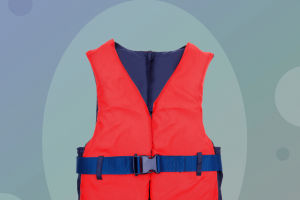Life jackets, also known as life vests, are an essential safety item for anyone who spends time on or near the water. They are designed to keep the wearer afloat and safe in case of an accidental fall into the water.
The principle of the lifejacket is to inflate automatically according to the action of the water (fully automatic inflatable lifejacket), or by pulling the cable on the inflatable valve by hand (manual inflatable lifejacket).
It will be inflated within 5 seconds to produce 8-15 kg of buoyancy, which will lift the body upwards, so that the head and shoulders of the person who fell in will be exposed to the water, and will be safely protected in time.
There are different types of life jackets available. Buoyant material-filled life jackets are made of nylon or neoprene fabric and filled with buoyant material in the middle. Inflatable life jackets are made from strong, waterproof materials, similar to the principle of an inflatable life buoy or swimming ring.
They are available in automatic or passive inflatable versions. However, this type of lifejacket should be careful to avoid sharp objects poking through or abrading the waterproof layer, which can have serious consequences when air leaks.
Life jackets should be as brightly colored as possible, such as red and yellow, because they make it easier for rescuers to spot you if the wearer accidentally falls into the water. Secondly, life jackets generally have a protective effect on your body to keep you out of harm's way.
When wearing a lifejacket in the water, the buoyancy of the front and back pieces of the lifejacket should be in the correct proportion, generally, the front piece must be more buoyant than the back piece and should allow the wearer to remain upright or lean back slightly to ensure that the mouth is exposed to the water and that there is no tendency to submerge the wearer's face in the water.
Life jackets are a guarantee of life and should be cared for properly. They should not be machine washed or dry cleaned, nor should they be bleached or tumble dried in a washing machine. When cleaning lifejackets it is recommended that a neutral detergent is used and that they are wiped with a damp towel, not soaked in water, or washed with a more aggressive detergent.
Life jackets should be stored in the shade to avoid accelerated aging and reduced life expectancy due to exposure to sunlight. Attention should also be paid to keeping them dry and clean to prevent them from becoming moldy and affecting their use.
In conclusion, life jackets are an essential safety item for anyone who spends time on or near the water. They are designed to keep the wearer afloat and safe in case of an accidental fall into the water.
Different types of life jackets are available, and they should be as brightly colored as possible, to make it easier for rescuers to spot you. Life jackets should be cared for properly, and stored in the shade to avoid accelerated aging and reduced life expectancy.


